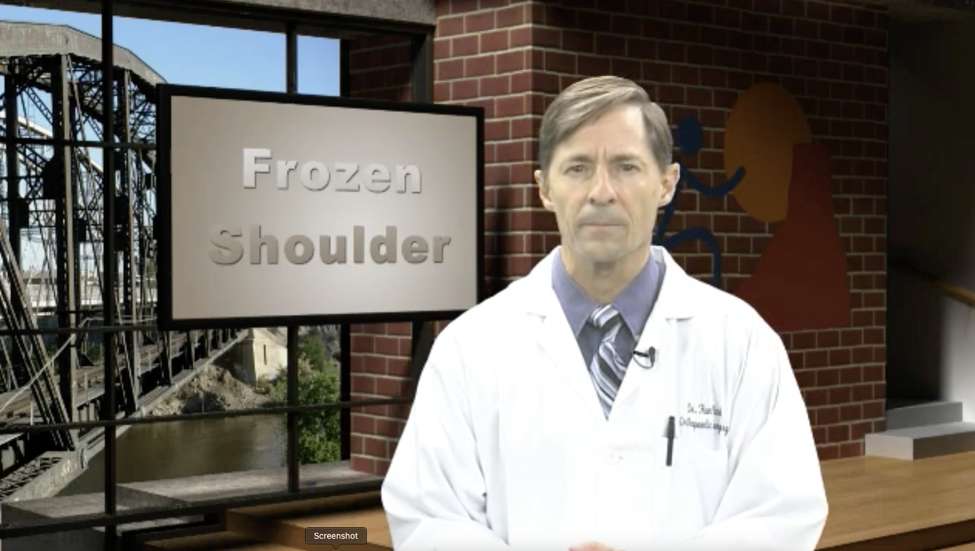How to Treat a Frozen Shoulder
November 9, 2022
Hello and welcome to Yuma Health and Happenings. I’m Dr. Ron Clark, Orthopedic Surgeon and founder of The Bone and Joint Center of Yuma. Today I want to talk about the shoulder with its complex form and functions. We’ll also discuss what happens when the shoulder stops performing those functions.
Understanding the Shoulder
The shoulder is comprised of three separate bones, the arm bone, the shoulder blade bone, and the collar bone. The shoulder is connected to the rest of the body by the inner end of the collar bone and supported by muscles that connect to the neck and upper back.
The shoulder blade is completely covered by muscles and lies on the back of the rib cage. The major joint of the shoulder is where the arm bone and the shoulder blade meet but the end of the collar bone also connects with the shoulder blade at a different location and is also a flexible joint.
The fact that the shoulder blade can glide over the rib cage makes for a third joint and increases the movement that our arms can make. The surface covering the arm bone and shoulder blade socket is called joint cartilage and is 70% water. This surface allows the two ends of the bone to move smoothly over each other.
Because the upper end of the arm bone is round and the shoulder blade bone forms a shallow cup, the shoulder is considered a ball and socket joint. This explains how we can use our shoulders to move our hands nearly all around our head and body and is the joint of the body with the greatest amount of movement.
Since the socket side of the joint is much smaller than the arm bone is, a great deal of force and energy can be passed through the muscles and tissues that hold the shoulder together. Many of the common shoulder problems occur around the muscles and the tissues that are supposed to hold the shoulder bones together.
Diagnosing a Frozen Shoulder
One of the problems that can cause pain and limited movement of the shoulder is called adhesive capsulitis. This condition has been given the nickname of “frozen shoulder.” The cause of this problem is not well understood but the location of the problem seems to be the joint lining itself.
The lining becomes reddened due to increased blood flow and eventually becomes thicker and less flexible. The result of these changes is that the shoulder becomes progressively harder to move and more painful when attempts to move it are made.
This entity is rare before the age of thirty and can happen without warning throughout life but most commonly between the ages of 40 through 60. It is found more frequently in women than men and when it occurs in those who have diabetes, they seem to have a more severe type of the condition and it seems to take longer to recover.
Other disease conditions such as thyroid disease, heart disease, and Parkinson’s disease show an increased risk of getting a frozen shoulder. Sometimes it will occur after a mild shoulder stretch from a fall or minor auto accident, especially if the shoulder was protected in a sling for a period.
There seems to be three distinct phases to frozen shoulder. The first phase is called the freezing stage where the shoulder is the most painful and is losing the amount of movement that is possible. This phase can last between 6 weeks and 9 months.
The next stage is called the frozen stage because the pain seems to lessen at this point and the shoulder seems to no longer be getting worse and seems to have leveled off as to what types of activities are tolerated by the patient. This phase tends to last 4-6 months and is frustrating as many of the simple activities of life, such as dressing and grooming, are difficult.
The final phase is known as the thawing phase as improvements in shoulder movement begin to occur. For a complete recovery or nearly complete recovery, 6 months to 2 years are likely.
The diagnosis of frozen shoulder is made after obtaining x-rays, the medical events related to the individual, and performing a physical examination. A closely related problem called shoulder bursitis can have several common features and will sometimes be mis-diagnosed as frozen shoulder. The MRI is not necessary to make the diagnosis of frozen shoulder but will show a characteristic change to shoulder that will confirm the diagnosis.
Seeking Treatment for a Frozen Shoulder
Treatments for frozen shoulder include oral anti-inflammatory medications, injections of cortisone medications into the shoulder joint, and physical therapy for stretching and strengthening of the shoulder. While 90% of persons will recover without the need for surgery, it may take over 2 years before the person will feel fully recovered.
For those that do not improve with injections and stretching, surgical treatment can be considered and will be helpful. Here the surgeon will physically stretch the joint while the patient is under the effects of anesthesia and will release the stiffened joint capsule from the bones of the shoulder joint.
While surgery is helpful, it will still be several weeks or even months of continued stretching before the shoulder has recovered so surgery is never the first recommended treatment. For those who have diabetes or other disease conditions, there seems to be about a 50% chance that the other shoulder may also develop frozen shoulder in the future and there is a very small chance that it can recur in the same side at a future time.
For help with a frozen shoulder, contact The Bone and Joint Center of Yuma. Schedule an appointment with Dr. Ron Clark to get the care you need.